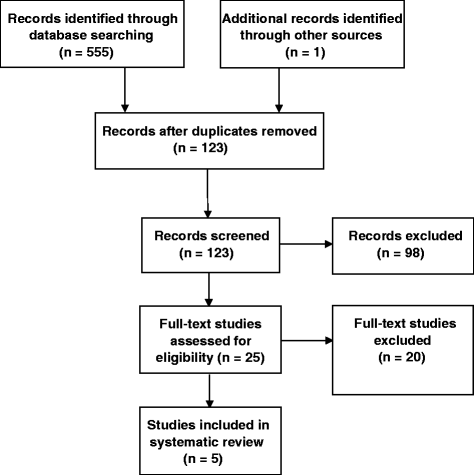The effectiveness of extracorporeal shock wave therapy for the treatment of lower limb ulceration: a systematic review
- PMID: 25722746
- PMCID: PMC4342213
- DOI: 10.1186/s13047-014-0059-0
The effectiveness of extracorporeal shock wave therapy for the treatment of lower limb ulceration: a systematic review
Abstract
Extracorporeal shock wave therapy has been reported as an effective treatment for lower limb ulceration. The aim of this systematic review was to investigate the effectiveness of extracorporeal shock wave therapy for the treatment of lower limb ulceration. Five electronic databases (Ovid MEDLINE, CINAHL, Web of Knowledge, Scopus and Ovid AMED) and reference lists from relevant studies were searched in December 2013. All study designs, with the exception of case-reports, were eligible for inclusion in this review. Assessment of each study's methodological quality was performed using the Quality Index tool. The effectiveness of studies was measured by calculating effect sizes (Cohen's d) from means and standard deviations. Five studies, including; three randomised controlled trials, one quasi-experimental study and one case-series design met our inclusion criteria and were reviewed. Quality assessment scores ranged from 38 to 63% (mean 53%). Improvements in wound healing were identified in these studies following extracorporeal shock wave therapy. The majority of wounds assessed were associated with diabetes and the effectiveness of ESWT as an addition to standard care has only been assessed in one randomised controlled trial. Considering the limited evidence identified, further research is needed to support the use of extracorporeal shock wave therapy in the treatment of lower limb ulceration.
References
-
- Fioramonti P, Onesti MG, Fino P, Fallico N, Scuderi N. Extracorporeal shock wave therapy for the treatment of venous ulcers in the lower limbs. Ann Ital Chir. 2012;83(1):41–4. - PubMed
-
- Mittermayr R, Antonic V, Hartinger J, Kaufmann H, Redl H, Téot L, et al. Extracorporeal shock wave therapy (ESWT) for wound healing: technology, mechanisms, and clinical efficacy. Wound Repair Regen. 2012;20(4):456–65. - PubMed
LinkOut - more resources
Full Text Sources
Other Literature Sources
Miscellaneous


